Lie-Liang Yang
CDMA/OTFS Sensing Outperforms Pure OTFS at the Same Communication Throughput
Jan 20, 2025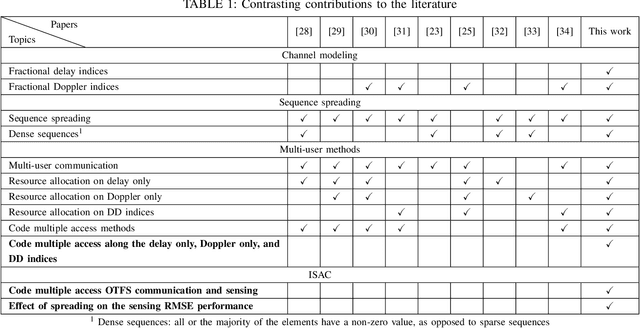
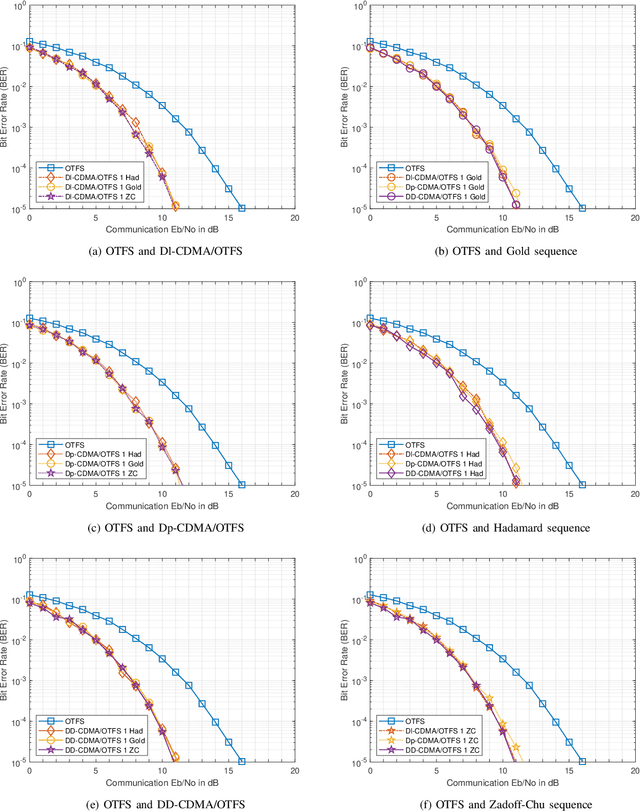

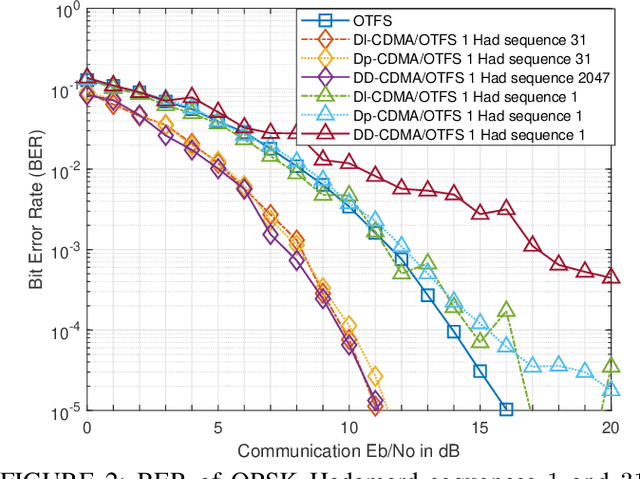
Abstract:There is a dearth of publications on the subject of spreading-aided Orthogonal Time Frequency Space (OTFS) solutions, especially for Integrated Sensing and Communication (ISAC), even though Code Division Multiple Access (CDMA) assisted multi-user OTFS (CDMA/OTFS) exhibits tangible benefits. Hence, this work characterises both the communication Bit Error Rate (BER) and sensing Root Mean Square Error (RMSE) performance of CDMA/OTFS, and contrasts them to pure OTFS. Three CDMA/OTFS configurations are considered: Delay Code Division Multiple Access OTFS (Dl-CDMA/OTFS), Doppler Code Division Multiple Access OTFS (Dp-CDMA/OTFS), and Delay Doppler Code Division Multiple Access OTFS (DD-CDMA/OTFS), which harness direct sequence spreading along the delay axis, Doppler axis, and DD domains respectively. For each configuration, the performance of Gold, Hadamard, and Zadoff-Chu sequences is investigated. The results demonstrate that Zadoff-Chu Dl-CDMA/OTFS and DD-CDMA/OTFS consistently outperform pure OTFS sensing, whilst maintaining a similar communication performance at the same throughput. The extra modulation complexity of CDMA/OTFS is similar to that of other OTFS multi-user methodologies, but the demodulation complexity of CDMA/OTFS is lower than that of some other OTFS multi-user methodologies. CDMA/OTFS sensing can also consistently outperform OTFS sensing whilst not requiring any additional complexity for target parameter estimation. Therefore, CDMA/OTFS is an appealing candidate for implementing multi-user OTFS ISAC.
Generalized Spatial Modulation Aided Affine Frequency Division Multiplexing
Jan 18, 2025Abstract:Generalized spatial modulation-aided affine frequency division multiplexing (GSM-AFDM) is conceived for reliable multiple-input multiple-output (MIMO) communications over doubly selective channels. We commence by proposing several low-complexity detectors for large-scale GSM-AFDM systems. Specifically, we introduce the linear minimum mean square error (LMMSE) equalizer-based maximum likelihood detector (LMMSE-MLD). By exploiting the GSM properties, we then derive the LMMSE-based transmit-antenna activation pattern (TAP) check-based log-likelihood ratio detector (LMMSE-TC-LLRD). In addition, we propose a pair of new detectors, namely the greedy residual check detector (GRCD) and the reduced space check detector (RSCD). We also derive a bit error rate (BER) upper-bound by considering the MLD. Our simulation results demonstrate that 1) the BER upper bound derived is tight for moderate to high signal-to-noise ratios (SNRs), 2) the proposed GSM-AFDM achieves lower BER than its conventional counterparts, and 3) the conceived detectors strike a compelling trade-off between the BER and complexity.
Space-Air-Ground Integrated Networks: Their Channel Model and Performance Analysis
Dec 21, 2024Abstract:Given their extensive geographic coverage, low Earth orbit (LEO) satellites are envisioned to find their way into next-generation (6G) wireless communications. This paper explores space-air-ground integrated networks (SAGINs) leveraging LEOs to support terrestrial and non-terrestrial users. We first propose a practical satellite-ground channel model that incorporates five key aspects: 1) the small-scale fading characterized by the Shadowed-Rician distribution in terms of the Rician factor K, 2) the path loss effect of bending rays due to atmospheric refraction, 3) the molecular absorption modelled by the Beer-Lambert law, 4) the Doppler effects including the Earth's rotation, and 5) the impact of weather conditions according to the International Telecommunication Union Recommendations (ITU-R). Harnessing the proposed model, we analyze the long-term performance of the SAGIN considered. Explicitly, the closed-form expressions of both the outage probability and of the ergodic rates are derived. Additionally, the upper bounds of bit-error rates and of the Goodput are investigated. The numerical results yield the following insights: 1) The shadowing effect and the ratio between the line-of-sight and scattering components can be conveniently modeled by the factors of K and m in the proposed Shadowed-Rician small-scale fading model. 2) The atmospheric refraction has a modest effect on the path loss. 3) When calculating the transmission distance of waves, Earth's curvature and its geometric relationship with the satellites must be considered, particularly at small elevation angles. 3) High-frequency carriers suffer from substantial path loss, and 4) the Goodput metric is eminently suitable for characterizing the performance of different coding as well as modulation methods and of the estimation error of the Doppler effects.
Energy Efficient Beamforming Training in Terahertz Communication Systems
Sep 27, 2024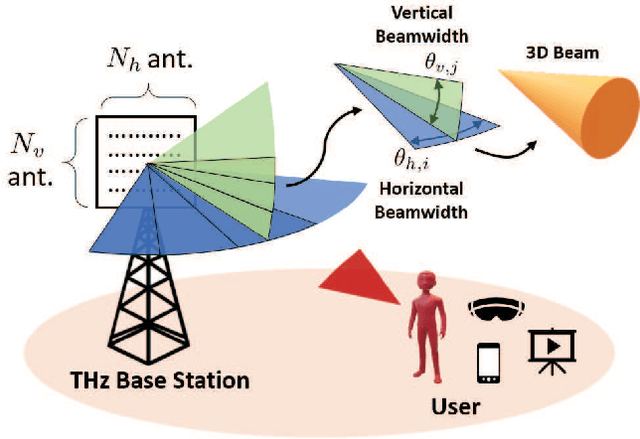
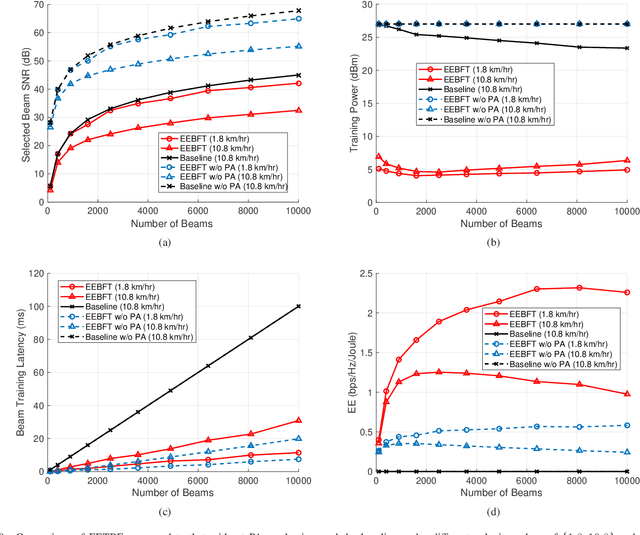

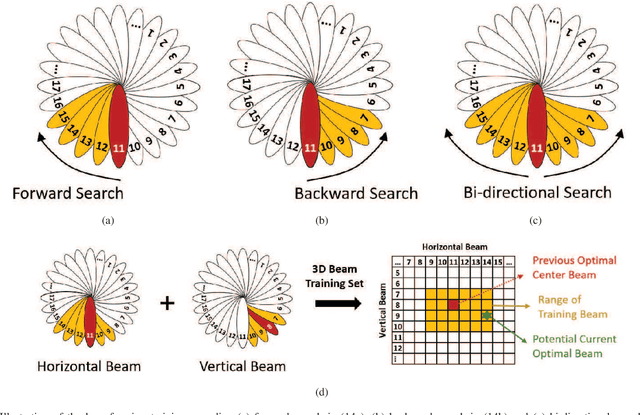
Abstract:Terahertz (THz) enables promising Tbps-level wireless transmission thanks to its prospect of ultra-huge spectrum utilization and narrow beamforming in the next sixth-generation (6G) communication system. Compared to millimeter wave (mmWave), THz intrinsically possesses compellingly severer molecular absorption and high pathloss serving confined coverage area. These defects should be well conquered under the employment of ultra-thin 3D beamforming with enormous deployed antennas with high beam gains. However, pencil-beams require substantially high overhead of time and power to train its optimal THz beamforming direction. We propose an energy efficient (EE) oriented THz beamforming (EETBF) scheme by separating the original complex problem into beamforming training (EETBF-BT) acquirement and learning-enabled training power assignment (EETBF-PA). The historical beam data is employed to update next beam selection policy. The performance results have demonstrated that the proposed EETBF outperforms the existing benchmarks leveraging full beam search, iterative search, linear/binary search as well as non-power-control based mechanism in open literature. Our proposed EETBF scheme results in the lowest training latency and power consumption, achieving the highest effective rate and EE performance.
User-Centric Cell-Free (UCCF) Wireless Systems: Principles and Optimization
Apr 19, 2024



Abstract:User-centric cell-free (UCCF) wireless networks have a range of distinguished characteristics, which can be exploited for meeting some challenges that the conventional cellular systems are hard to. This chapter is devoted to delivering the fundamentals of wireless communications in UCCF systems, including channel modeling and estimation, uplink (UL) detection, downlink (DL) transmission, and resource optimization. Specifically, the advantages of cell-free networking are examined in contrast to the conventional celluar systems. The global and location-aware distributed UL detection are explored in the principles of minimum mean-square error (MMSE) and brief propagation. Correspondingly, the global and distributed DL transmission schemes are designed based on the MMSE precoding. The optimization of both UL and DL is analyzed with respect to system design and resource-allocation. Furthermore, some challenges for the implementation of UCCF systems in practice are identified and analyzed.
Optimization for MIMO Integrated Sensing and Communications
Mar 21, 2024



Abstract:The fundamentals of MIMO communications and MIMO sensing are firstly analyzed with regard to channel and sensing capacities. It is shown that the different objectives of communications and sensing lead to different signaling waveforms required for achieving their capacities. Hence, the optimization of integrated sensing and communications (ISAC) is relied on a trade-off expected between the performance of communications and that of sensing. Following this observation, the design and resource optimization in general MIMO ISAC systems are discussed along with the analysis of some existing ISAC schemes. Furthermore, the design of ISAC in mmWave communications is addressed. Specifically, the principle of sensing in mmWave systems is established, and a range of optimization alternatives for ISAC design in mmWave systems are reviewed.
Principles and Optimization of Reflective Intelligent Surface Assisted mmWave Systems
Mar 17, 2024



Abstract:A conceptual example is first analyzed to show that efficient wireless communications is possible, when user equipment (UE) receiver, BS transmitter or/and the scatter (reflector) in wireless channels employ the required channel state information (CSI) to remove the randomness of signal phase. Then, the principles and optimization of three reflective intelligent surface (RIS) assisted mmWave (RIS-mmWave) models are introduced. The first model assumes one BS, one RIS and one UE; the second one assumes one BS, one RIS and multiple UEs; while the third RIS-mmWave model assumes one BS, multiple RISs and multiple UEs. Furthermore, the optimization of BS precoder and RIS phase-shifts is addressed in the context of the massive RIS-mmWave scenarios, where the number of BS antennas and that of RIS reflection elements are significantly larger than the number of supported UEs. The analyses demonstrate that, while the deployment of RISs with mmWave is capable of solving the blockage problem and has the potential to significantly improve efficiency, finding the near-optimum solutions for RIS phase-shifts is highly challenging in practice.
Molecular Code-Division Multiple-Access: Signaling, Detection, and Performance
Feb 25, 2024Abstract:To accomplish relatively complex tasks, in Internet of Bio-Nano Things (IoBNT), information collected by different nano-machines (NMs) is usually sent via multiple-access channels to fusion centers (FCs) for further processing. Relying on two types of molecules, in this paper, a molecular code-division multiple-access (MoCDMA) scheme is designed for multiple NMs to simultaneously send information to an access-point (AP) in a diffusive molecular communications (DMC) environment. We assume that different NMs may have different distances from AP, which generates `near-far' effect. Correspondingly, the uniform and channel-inverse based molecular emission schemes are proposed for NMs to emit information molecules. To facilitate the design of different signal detection schemes, the received signals by AP are represented in different forms. Specifically, by considering the limited computational power of nano-machines, three low-complexity detectors are designed in the principles of matched-filtering (MF), zero-forcing (ZF), and minimum mean-square error (MMSE). The noise characteristics in MoCDMA systems and the complexity of various detection schemes are analyzed. The error performance of the MoCDMA systems with various molecular emission and detection schemes is demonstrated and compared. Our studies and performance results demonstrate that MoCDMA constitutes a promising scheme for supporting multiple-access transmission in DMC, while the channel-inverse based transmission can ensure the fairness of communication qualities (FoCQ) among different NMs. Furthermore, different detection schemes may be implemented to attain a good trade-off between implementation complexity and communication reliability.
Localization in Reconfigurable Intelligent Surface Aided mmWave Systems: A Multiple Measurement Vector Based Channel Estimation Method
Feb 25, 2024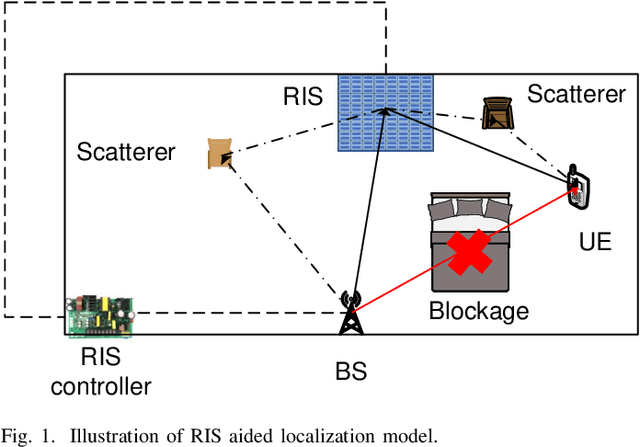
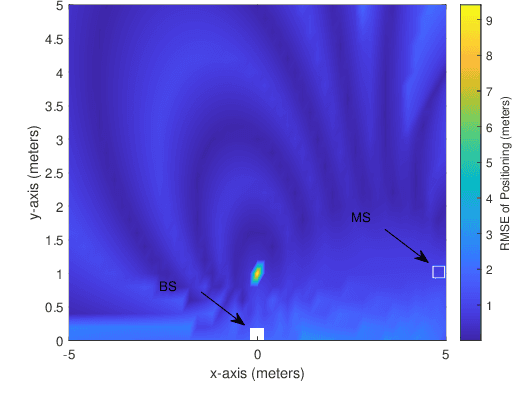
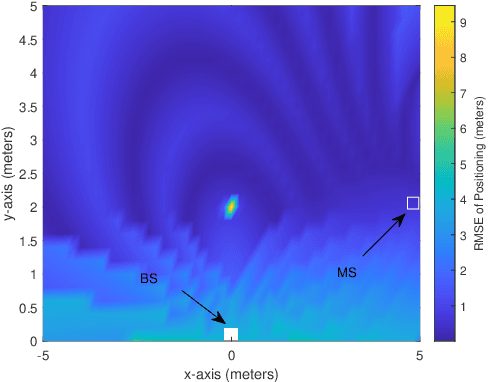
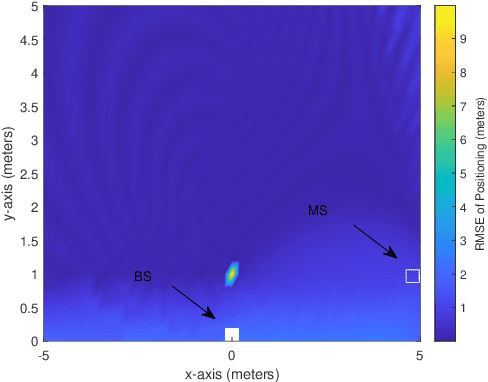
Abstract:The sparsity of millimeter wave (mmWave) channels in the angular and temporal domains is beneficial to channel estimation, while the associated channel parameters can be utilized for localization. However, line-of-sight (LoS) blockage poses a significant challenge on the localization in mmWave systems, potentially leading to substantial positioning errors. A promising solution is to employ reconfigurable intelligent surface (RIS) to generate the virtual line-of-sight (VLoS) paths to aid localization. Consequently, wireless localization in the RIS-assisted mmWave systems has become the essential research issue. In this paper, a multiple measurement vector (MMV) model is constructed and a two-stage channel estimation based localization scheme is proposed. During the first stage, by exploiting the beamspace sparsity and employing a random RIS phase shift matrix, the channel parameters are estimated, based on which the precoder at base station and combiner at user equipment (UE) are designed. Then, in the second stage, based on the designed precoding and combining matrices, the optimal phase shift matrix for RIS is designed using the proposed modified temporally correlated multiple sparse Bayesian learning (TMSBL) algorithm. Afterwards, the channel parameters, such as angle of reflection, time-of-arrival, etc., embedding location information are estimated for finally deriving the location of UE. We demonstrate the achievable performance of the proposed algorithm and compare it with the state-of-the-art algorithms. Our studies show that the proposed localization scheme is capable of achieving centimeter level localization accuracy, when LoS path is blocked. Furthermore, the proposed algorithm has a low computational complexity and outperforms the legacy algorithms in different perspectives.
Orthogonal Time-Frequency-Space (OTFS) and Related Signaling
Jan 24, 2024Abstract:The principle of orthogonal time-frequency-space (OTFS) signaling is firstly analyzed, followed by explaining that OTFS embeds another signaling scheme referred to as orthogonal short-time Fourier (OSTF). Then, the relationship among OTFS, OSTF, orthogonal frequency-division multiplexing (OFDM) and single-carrier frequency-division multiple-access (SC-FDMA) is explored, demonstrating that OSTF/OTFS are fundamentally the extensions of OFDM/SC-FDMA from one-dimensional (1D) signaling to two-dimensional (2D) signaling. Hence, the characteristics and performance of OSTF/OTFS schemes can be perceived from the well-understood OFDM/SC-FDMA schemes. Accordingly, the advantages and disadvantages of OSTF/OTFS are discussed. Furthermore, from the principles of OFDM/SC-FDMA, the multiuser multiplexing in OSTF/OTFS systems is analyzed with respect to uplink and downlink, respectively. Added on this, a range of generalized multiplexing schemes are presented, whose characteristics are briefly analyzed.
 Add to Chrome
Add to Chrome Add to Firefox
Add to Firefox Add to Edge
Add to Edge